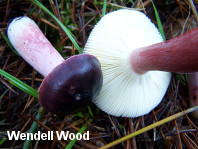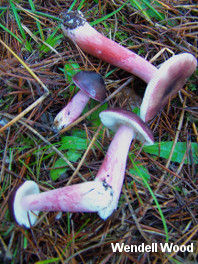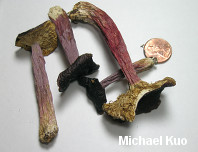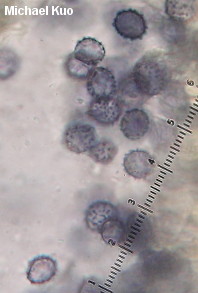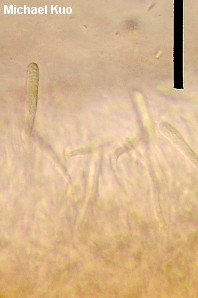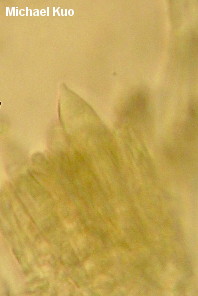| Major Groups > Gilled Mushrooms > Pale-Spored > Russula > Russula queletii |

|
Russula queletii [ Basidiomycota > Russulales > Russulaceae > Russula . . . ] by Michael Kuo Russula queletii is fairly easily distinguished on the basis of its purple cap and stem, its association with conifers, its whitish to cream-colored spore print, its acrid taste, and its ellipsoid spores with relatively isolated warts. The true Russula queletii of Europe is associated primarily with spruces, and is probably distinct from our North American versions, some of which associate with spruce, but others of which associate with pines (especially the two-needled species). Curiously, the white-spored North American versions of Russula sanguinea, which feature a bright red cap and stem, are virtually identical to Russula queletii, except in the red-versus-purple difference . . . and they also often associate with two-needled pines. Thanks to Wendell Wood for collecting, documenting, and preserving Russula queletii for study; his collection is deposited in The Herbarium of Michael Kuo. Description: Ecology: Mycorrhizal with conifers, especially spruces and 2-needled pines; growing alone, scattered, or gregariously; summer and fall; widely reported in western and northern North America. The illustrated and described collection is from northern California. Cap: 3-8 cm; convex or bell-shaped when young, becoming broadly convex, flat, or shallowly depressed; sticky at first or when wet; bald; dark blackish purple when young, becoming deep purple or brownish purple (sometimes also reported with greenish shades mixed in); the margin lined by maturity; the skin peeling easily 1/2-2/3 to the center. Gills: Broadly attached to the stem or just beginning to run down it; close; white to creamy. Stem: 3-8 cm long; 1-2 cm thick; pale to dark purple or pinkish purple; bald or slightly hairy; sometimes staining yellow at the base. Flesh: White; unchanging when sliced. Odor and Taste: Odor not distinctive, or sometimes sweetish and slightly fruity; taste acrid. Dried Specimens: Cap and stem retaining purple shades; gills dull yellowish. Chemical Reactions: KOH on cap surface reddish orange. Iron salts pale pink on stem surface. Spore Print: White to creamy. Microscopic Features: Spores 7-9 x 5-6 µ; ellipsoid; with isolated amyloid warts to 1 µ high; connectors scattered and rare. Pleuro-and cheilomacrocystidia cylindric to fusiform; hyaline in KOH; abundant; to about 75 x 12 µ. Pileipellis an ixotrichoderm; pileocystidia abundant, cylindric to subclavate, ochraceous-refractive in KOH and positive in sulphovanillin. REFERENCES: Fries, 1872. (Saccardo, 1887; Burlingham, 1915; Kibby & Fatto, 1990; Breitenbach & Kränzlin, 2005; McNeil, 2006; Miller & Miller, 2006; Trudell & Ammirati, 2009.) Herb. Kuo 10271401. This site contains no information about the edibility or toxicity of mushrooms. |
© MushroomExpert.Com |
|
Cite this page as: Kuo, M. (2014, November). Russula queletii. Retrieved from the MushroomExpert.Com Web site: http://www.mushroomexpert.com/russula_queletii.html |
